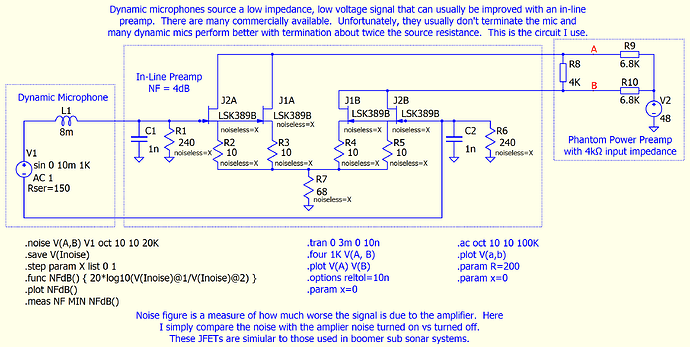For this week’s QSPICE schematic capture, we’re following Mike’s deep dive into designing a better microphone preamp. (Schematic Capture Post #012)
In-Line Preamp Dynamic Microphone.qsch (15.7 KB)
Mike just got a Shure SM7B microphone for podcasting, voice overs, and even general video conferencing. It supplies a low impedance, low level signal because it doesn’t include a transformer as many other dynamic mics use. His preamp/channel strip benefits from the extra gain of an in-line preamp. Also, the SM7B also benefits from a termination resistance to lower the Q of its resonances. There are many off-the-shelf in-line preamps available. While many pro audio preamps allow microphone termination to be selected, few in-line preamps do.
Mike didn’t try the CloudLifter because its cascode design puts the lower JFETs in the triode region, where he didn’t like the noise performance[1]. He didn’t believe that circuit could have as good noise performance as a solution that puts JFETs in parallel and operating in the saturation region such as the FetHead. (This example uses LSK389Bs, the IF389B will also work here.)
However, the FetHead doesn’t add any termination so the mic operates undamped, yielding a distracting sound. Mike added resistors to terminate the FetHead (it comes apart like a Chinese finger trap) and compared it to a homemade circuit with LSK389Bs that also terminated the mic.
Including termination in the preamp degrades the noise performance, so there’s a trade between sonic distraction and noise floor.
It’s not clear that a JFET solution is the best here, since it means putting all the energy from the mic into a resistor and then reading out the voltage on the resistor. After some experimentation, the circuit above sounded best and does perform better than the FetHead. In principle, a bipolar solution could do better, if one could find the right bipolars to use. But it’d be very hard to achieve the noise performance so casually achieved with this circuit. Mike’s homemade version is overkill – the source resistors, which reduce distortion if the FETs aren’t matched, are not necessary and paralleling devices decreases the noise figure by only one dB. Note the homemade preamp termination implementation attenuates common mode noise more than the normal mode signal which is a plus. A practical version of this circuit, without source degeneration or paralleled devices, is in the QSPICE Examples directory in the interest of demonstrating a straightforward way of simulating noise figure.
The homemade solution has decisively less noise than the FetHead, but the FetHead, even terminated, is at or below the self-noise of the SM7B. Unterminated, the FetHead is far below the self-noise of the SM7B. The home made solution has a dynamic range of close to 90dB between talking and silence.
1] There’s a story here. Berkeley SPICE incorrectly computes the noise of a JFET operating in the triode region. This can lead to underestimating the noise by orders of magnitude. HSPICE introduce JFET model parameters NLEV and GDSNOI to correct the problem. These parameters are supported in QSPICE. It’s interesting that the CloudLifter patent drawings were done with LTspice and might not have handled JFET noise correctly in the triode region.
Please send any schematic capture submissions to me at tim.mccune@qorvo.com
